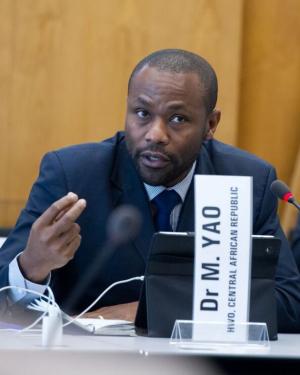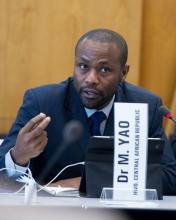Health is a bridge from crisis to sustainable development
By Dr Michel Yao
WHO Representative to Central African Republic
Three years of conflict have left a heavy toll on the people of the Central African Republic – a country among the 10 poorest in the world. Nearly one million people are still uprooted from their homes and communities. Half of the total population of 4.6 million people lack access to essential health services. Whilst a peace process slowly takes hold, the people need support to recover and rebuild, and health plays an essential role.
On 30 March, a new chapter of hope was ushered in with the inauguration of the Central African Republic’s President Faustin-Archange Touadéra, bringing an end to conflict that displaced nearly 450 000 people inside the country, and another 420 000 who fled to neighbouring countries.
While there have been slight improvements in the security situation in parts of the Central African Republic, the peace process is embryonic and remains fragile. As the country tentatively steps forward, investing in health offers a fighting chance towards lasting peace and sustainable development. Any threats to health such as a disease outbreak could endanger the recovery process and the return to peace.
The World Health Organization (WHO) is committed to rebuilding the health system and helping the country achieve the Sustainable Development Goals and their objective to leave no one behind by 2030. The problem is that the rest of the world has forgotten about the crisis in Central African Republic and health is severely underfunded here.
Years of war have weakened an already fragile health system. Only 55% of health facilities in the country are functioning, and most rely on support from non-governmental organizations and UN agencies like WHO. The Central African Republic has one of the highest rates of maternal deaths in the world – 9 in every 1000 mothers die in pregnancy and childbirth. Only one child out of two is fully immunized before the age of one year. Some 1.3 million people in the Central African Republic do not have access to a secure food supply, and this could exacerbate the risk of severe malnutrition that was already high in late 2014.
Two thirds of people do not have access to clean water and sanitation. In settlements for internally displaced persons, overcrowded conditions and poor access to safe water and sanitation increase the risk of diseases such as respiratory infections, diarrhoea, hepatitis E and cholera.
In parts of Bangui, the battle scars of war are widely evident from the pot-holed studded roads and crumbling buildings. Less visible however, are the vacant lifeless stares from children who have grown up too early. Young boys who were forced to become child soldiers and young girls who have been gang raped and stigmatized. WHO is committed to supporting programmes that provide pyscho-social support to help these young people recover and realize their potential.
Investing in health – a bridge to development
If we are to see lasting peace and achieve sustainable development, investing in health is essential – both during protracted conflict and once the conflict is over, to help get the country back on the road to recovery.
Healthy people are vital to rebuilding stronger economies and societies.
It is estimated that 60% of preventable maternal deaths, 53% of under-five deaths, and 45% of newborn deaths take place in settings of conflict, displacement and natural disasters. If we don’t address the health needs of the most vulnerable people in countries affected by crises and conflict, we will never achieve sustainable development.
Almost all of the 17 Sustainable Development Goals contribute to improved health outcomes – either directly or indirectly. The health goal (SDG3) specifically sets out to “Ensure healthy lives and promote well-being for all at all ages.” Two of the key indicators expected to show success will be major reductions in preventable deaths of mothers and children.
Yet, the health sector in this country remains consistently underfunded. The World Health Organization and partners aim to provide health services to 2.2 million people in Central African Republic this year. The need for the humanitarian health response is US$ 42.1 million. Of this, WHO needs US$ 15. 8 million for such work as setting up early warning systems for detecting disease outbreaks, responding to these outbreaks and helping restore basic health services. So far, we have only received US$ 2 million (12.65% of what we need this year) – a donation from Japan.
Shifting from delivering aid to ending need
Achieving the Sustainable Development Goals will depend on strengthened relationships among governments, communities, humanitarian and development actors who must come together to respond to the crisis. First we need a strong strategy and plan to save lives and ensure restoration of basic services and then to move progressively towards a sustainable development approach to achieve real change in the lives of the people we serve. This approach requires long-term flexible funding.
We can get better results if we shift humanitarian actions from what the UN Secretary-General has called “delivering aid to ending need″. As an organization that works across both humanitarian and development spheres, WHO brings together the humanitarian response and health system strengthening, with the central uniting objective of protecting people’s health.
Since the beginning of the crisis, WHO has used its health resource availability monitoring system (known as HeRAMS) to gather information on what health facilities and services are functioning. Used in other countries in crises including Syria and Sudan, HeRAMS provides essential information for effective decision-making and allocating resources in emergencies. It is also being used in Central African Republic to develop preparedness and contingency plans, and to guide the restoration of key services that will contribute to longer term health development.
The World Humanitarian Summit is an important opportunity to help bridge the development and humanitarian divide. WHO is actively engaged in UN efforts to adapt existing humanitarian practices to better support longer-term planning for development and better resilience to crises. Greater collaboration between humanitarian and development partners will help ensure that limited resources are used in the most effective way to help affected countries to build back strong, healthy societies that can stand on their own in the face of future crises.




